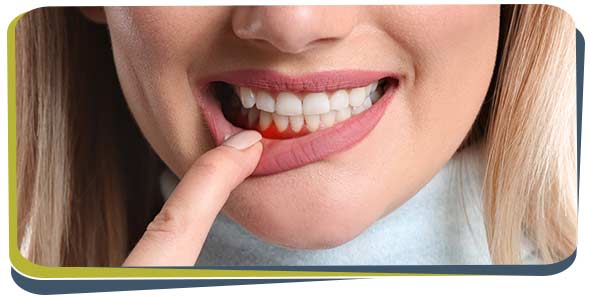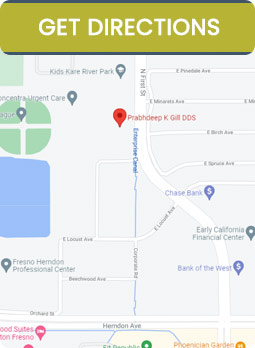Gum Disease Treatment in Fresno, CA
Dr. Prabhdeep K. Gill offers effective gum disease treatment in Fresno, CA, focusing on restoring gum health and preventing further damage. Using advanced techniques, she provides both non-surgical and surgical options tailored to your needs. Trust Dr. Gill for gentle, comprehensive care to maintain a healthy smile. For more information, contact us or request an appointment online today! We are conveniently located at 7215 N First St Suite 107 Fresno CA 93720.


Table of Contents:
Can gum disease be treated?
What are the signs of gum disease?
What causes gum disease?
What are the stages of gum disease?
There are multiple venues to treat gum disease. Treatments are available that do not require any surgery include:
• Professional dental cleaning
During your checkup, the dental hygienist Dr. Prabhdeep K. Gill will do a professional dental cleaning by removing the plaque and tartar that is built up and hardened on the tooth’s surface. They remove this from above and below the gum line on all of the teeth. It may be recommended to get a professional dental cleaning done twice or more a year if you have a form of gum disease.
• Scaling and root planing
This deep-cleaning, non-surgical treatment is done under local anesthetic. It removes plaque and tartar that have built up from above and below the gum line.
Surgical treatment options for gum disease, due to the severity of the disease, include:
• Flap surgery/pocket reduction surgery
During this treatment, your gums are lifted and tartar is removed. Once complete, the gums are then placed back snugly against the tooth to reduce the size of space between the gum and tooth, thereby decreasing any areas where the harmful bacteria can grow and decreasing the chance of serious health issues that are often associated with periodontal disease.
• Bone grafts
Bone Grafts involve fragments of your bone, synthetic bone, or even donated bone to replace your bone that was destroyed by gum disease. The grafts serve as a framework for the regrowth of your bone, which restores the stability of the teeth.
• Soft tissue grafts
Reinforces the gums or fills in areas where the gums have receded due to gum disease. Grafted tissue is then taken from the roof of the mouth, or is stitched in place, which adds tissue to the affected area.
• Guided tissue regeneration
This surgery is completed when the bone that supports the teeth has been destroyed. This surgery stimulates bone and gum tissue growth. This is often done in conjunction with flap surgery and keeps the gum tissue from growing into the area where it shouldn’t be.
• Bone surgery
Bone surgery is completed to smooth any shallow craters that are in the bone due to moderate or severe bone loss. Bone surgery is completed after flap surgery, and the bone around the tooth is reshaped to decrease any more craters from appearing, which makes it harder for the bacteria to collect and grow.
Prescription treatments are also often used in conjunction with surgery or other forms of therapy for gum disease, they help to temporarily reduce the bacteria that is associated with gum disease, or suppress the destruction of the tooth’s attachment to the bone due to gum disease.
• Chlorhexidine
• Doxycycline
• Tetracycline
• Minocycline
The main signs of gum disease include:
• Bad breath
• Bad taste that won’t go away even with brushing
• Red or swollen gums
• Tender or bleeding gums
• Loose teeth
• Sensitive teeth
• Gums that are beginning to pull away from your teeth
• Change in the way your teeth fit together when biting
• Changes in the fit of your partial dentures
Gum disease is caused by bacteria forming in the mouth and infecting the live tissues that surround the teeth. This leads to inflammation and redness in the tissue, and if not dealt with, it forms plaque, which begins to harden and turn into tartar. Tartar builds up below the gum line, making it difficult to clean the teeth. By then, only a professional can clean the teeth to remove the tartar and stop gum disease from getting worse.
There are four stages of gum disease, they are:
• Gingivitis
The only stage of periodontal disease that is reversible, and has not yet had the chance to attack the bone.
• Slight Periodontal Disease
The next three stages are not reversible, but stage two is manageable. The infection has spread to the bone and begun to destroy it.
• Moderate Periodontal Disease
The depths the bacteria reach are greater than six to seven millimeters, which allows for even more bacteria to attack not only the bones but also get into your bloodstream and wreak havoc on your immune system.
• Advanced Periodontal Disease
This is considered the most severe stage, where the infection has deepened further and the bacteria has evolved into a disease-causing bacterium. If you need help to achieve good gum health, contact us or request an appointment online today! We are conveniently located at 7215 N First St Suite 107 Fresno CA 93720. We serve patients from Clovis CA, West Park CA, Mayfair CA, Muscatel CA, Burness CA, Lone Star CA, and surrounding areas.
Check Out Our 5 Star Reviews


Additional Services You May Need
▸ Cosmetic Dentistry
▸ Dental Implants
▸ Crowns & Bridges
▸ Invisalign
▸ Tooth Restoration
▸ Maxillofacial Surgery
▸ Prosthodontics
▸ Dental Checkups and Cleaning
▸ Teeth Whitening
▸ Oral Cancer Screening
▸ Veneers
▸ Tooth Replacement
▸ Gum Disease
▸ Sports Guards
▸ Bruxism
▸ Night Guard
▸ Gingivitis Treatment
▸ Fillings
▸ Dentures
▸ Preventative
▸ Dental Emergencies
▸ General Dentistry
▸ Digital X-Rays







